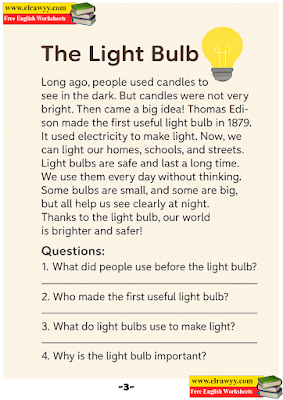Introducing children to the world of inventions can be both exciting and educational. One powerful way to do this is through reading comprehension activities. By using short, engaging stories, educators and parents can help kids understand how inventions shape our daily lives while improving their literacy. Below are key strategies and ideas for teaching inventions through reading comprehension.
1. Making Inventions Relatable
Children learn best when they can connect new ideas to their everyday experiences. Using reading passages that highlight common inventions—like the toothbrush, the bicycle, or the refrigerator—helps kids understand how these tools make life easier.
For example, a story about a child who uses a flashlight during a power outage not only introduces the invention but also shows its practical value. When kids can see how inventions relate to their own lives, they are more likely to be interested and engaged.
2. Building Vocabulary Through Context
Reading comprehension passages about inventions naturally introduce new vocabulary. Terms like "electricity," "materials," "design," or "solve" can be taught in context through simple, well-written stories.
By encountering these words in meaningful situations, students are more likely to remember them. Teachers can create follow-up activities where kids match words to pictures, explain meanings, or use the new words in their own sentences.
3. Encouraging Critical Thinking
Stories about inventions often involve a problem and a solution. This makes them perfect for developing critical thinking skills. After reading, students can be asked questions like:
-
What problem did the inventor try to solve?
-
How did the invention help people?
-
Can you think of another way to solve the same problem?
These types of questions help children think beyond the story and connect ideas to the real world.
4. Promoting Creativity and Innovation
Reading about inventors can inspire kids to become creative thinkers. After reading comprehension passages, children can be encouraged to draw or write about an invention they would like to make. This kind of creative extension blends literacy with imagination and innovation.
For instance, a story about the invention of the umbrella could lead to an activity where students design their own weather-related tools. This makes learning more dynamic and personal.
5. Making Learning Fun and Visual
Adding illustrations to reading comprehension texts makes the content more appealing, especially for visual learners. Black-and-white sketches or colorful images help students understand what the invention looks like and how it works.
Visual aids also help in comprehension, especially for younger children or those learning a second language. When kids enjoy what they read and see, they’re more likely to remember it.
Conclusion
Teaching children about inventions through reading comprehension is a practical and inspiring approach. It enhances vocabulary, critical thinking, creativity, and real-world understanding—all while developing strong reading skills. By choosing age-appropriate stories and pairing them with engaging activities, educators can spark both curiosity and learning in young minds. The inventions of the past can inspire the inventors of the future.


Post a Comment